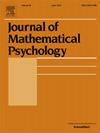Honey, I shrunk the irrelevant effects! Simple and flexible approximate Bayesian regularization
IF 1.5
4区 心理学
Q2 MATHEMATICS, INTERDISCIPLINARY APPLICATIONS
引用次数: 0
Abstract
In the social and behavioral sciences and related fields, statistical models are becoming increasingly complex with more parameters to explain intricate dependency structures among larger sets of variables. Regularization techniques, like penalized regression, help identify key parameters by shrinking negligible effects to zero, resulting in parsimonious solutions with strong predictive performance. This paper introduces a simple and flexible approximate Bayesian regularization (ABR) procedure, combining a Gaussian approximation of the likelihood with a Bayesian shrinkage prior to obtain a regularized posterior. Parsimonious (interpretable) solutions are obtained by taking the posterior modes. Parameter uncertainty is quantified using the full posterior. Implemented in the R package shrinkem, the method is evaluated in synthetic and empirical applications. Its flexibility is demonstrated across various models, including linear regression, relational event models, mediation analysis, factor analysis, and Gaussian graphical models.
亲爱的,我缩小了无关的效果!简单灵活的近似贝叶斯正则化
在社会和行为科学及相关领域,统计模型正变得越来越复杂,有更多的参数来解释更大的变量集之间复杂的依赖结构。正则化技术,如惩罚回归,通过将可忽略的影响缩小到零来帮助识别关键参数,从而产生具有强大预测性能的简洁解决方案。本文介绍了一种简单灵活的近似贝叶斯正则化(ABR)方法,将似然的高斯近似与贝叶斯收缩相结合来获得正则化后验。采用后验模态得到简约(可解释)解。参数的不确定性是用全后验量化的。在R封装收缩中实现,该方法在综合和经验应用中进行了评估。它的灵活性在各种模型中得到展示,包括线性回归、关系事件模型、中介分析、因素分析和高斯图形模型。
本文章由计算机程序翻译,如有差异,请以英文原文为准。
求助全文
约1分钟内获得全文
求助全文
来源期刊

Journal of Mathematical Psychology
医学-数学跨学科应用
CiteScore
3.70
自引率
11.10%
发文量
37
审稿时长
20.2 weeks
期刊介绍:
The Journal of Mathematical Psychology includes articles, monographs and reviews, notes and commentaries, and book reviews in all areas of mathematical psychology. Empirical and theoretical contributions are equally welcome.
Areas of special interest include, but are not limited to, fundamental measurement and psychological process models, such as those based upon neural network or information processing concepts. A partial listing of substantive areas covered include sensation and perception, psychophysics, learning and memory, problem solving, judgment and decision-making, and motivation.
The Journal of Mathematical Psychology is affiliated with the Society for Mathematical Psychology.
Research Areas include:
• Models for sensation and perception, learning, memory and thinking
• Fundamental measurement and scaling
• Decision making
• Neural modeling and networks
• Psychophysics and signal detection
• Neuropsychological theories
• Psycholinguistics
• Motivational dynamics
• Animal behavior
• Psychometric theory
 求助内容:
求助内容: 应助结果提醒方式:
应助结果提醒方式:


